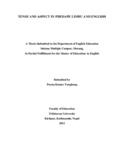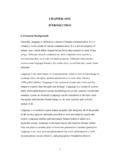Please use this identifier to cite or link to this item:
https://elibrary.tucl.edu.np/handle/123456789/3532Full metadata record
| DC Field | Value | Language |
|---|---|---|
| dc.contributor.author | Yonghang, Purna Kumar | - |
| dc.date.accessioned | 2021-07-26T10:44:20Z | - |
| dc.date.available | 2021-07-26T10:44:20Z | - |
| dc.date.issued | 2012 | - |
| dc.identifier.uri | http://elibrary.tucl.edu.np/handle/123456789/3532 | - |
| dc.description.abstract | The thesis entitled “Tense and Aspect in Phedape Limbu and English” tries to find out the tense and aspect system in the Phedape dialect of the Limbu language and to make a comparison between tense and aspect and their markers with those of English in terms of person and number. The researcher used both primary and secondary sources of data .He selected forty Limbu native speakers from Pathari VDC of Morang district and divided them into three strata; illiterate, literate and educated. The data were collected using the inteview questionnaire as a research tool. The researcher found out that the Limbu language has four aspects but only two aspect makers (i.e. progressive and perfect). English has four aspects and three aspect markers (progressive, perfect and perfect progressive). Limbu does not have future tense. In English future tense is expressed by 'will' and 'shall' but in the Limbu language by future time adverbs. English has only the third person singular marker '-s' whereas Limbu has more person and number markers. English has only simple past tense marker but Limbu has simple past, present continuous, past continuous, present perfect and past perfect tense markers. Limbu has person markers but Einglish does not. The thesis contains four chapters. The first chapter contains general background, review of the related literature, objectives of the study, significance of the study. The second chapter deals with methodology of the study and it includes the sources of data, population of the study, sampling procedure, research tool, process of data collection and limitation of the study. The third chapter deals with the analysis and interpretation of the collected data and comparison of Limbu and English tense and aspect system and the fourth chapter presents the findings and recommendations. | en_US |
| dc.language.iso | en_US | en_US |
| dc.publisher | Faculty of English Education | en_US |
| dc.subject | Linguistics Scenario | en_US |
| dc.subject | Language Teaching | en_US |
| dc.subject | Tense | en_US |
| dc.subject | English Language | en_US |
| dc.title | Tense and Aspect in Phedape Limbu and English | en_US |
| dc.type | Thesis | en_US |
| local.academic.level | Masters | en_US |
| local.affiliatedinstitute.title | Sukuna Multiple Campus, Morang | en_US |
| Appears in Collections: | English Language Education | |
Files in This Item:
| File | Description | Size | Format | |
|---|---|---|---|---|
| cover.pdf | 43.47 kB | Adobe PDF |  View/Open | |
| CHAPTER.pdf | 308.9 kB | Adobe PDF |  View/Open |
Items in DSpace are protected by copyright, with all rights reserved, unless otherwise indicated.
